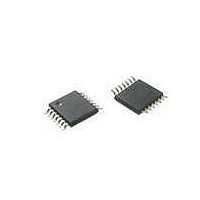ATTINY20-XU Atmel, ATTINY20-XU Datasheet - Page 152

ATTINY20-XU
Manufacturer Part Number
ATTINY20-XU
Description
MCU AVR 2KB FLASH 12MHZ 14TSSOP
Manufacturer
Atmel
Series
AVR® ATtinyr
Datasheet
1.ATTINY20-EK1.pdf
(224 pages)
Specifications of ATTINY20-XU
Core Processor
AVR
Core Size
8-Bit
Speed
12MHz
Connectivity
I²C, SPI
Peripherals
Brown-out Detect/Reset, POR, PWM, WDT
Number Of I /o
12
Program Memory Size
2KB (1K x 16)
Program Memory Type
FLASH
Ram Size
128 x 8
Voltage - Supply (vcc/vdd)
1.8 V ~ 5.5 V
Data Converters
A/D 8x10b
Oscillator Type
Internal
Operating Temperature
-40°C ~ 85°C
Package / Case
*
Processor Series
ATtiny
Core
AVR
Data Bus Width
8 bit
Data Ram Size
128 B
Interface Type
SPI, TWI
Maximum Clock Frequency
12 MHz
Number Of Programmable I/os
12
Number Of Timers
2
Operating Supply Voltage
3.3 V
Maximum Operating Temperature
+ 85 C
Mounting Style
SMD/SMT
Minimum Operating Temperature
- 40 C
Operating Temperature Range
- 40 C to + 85 C
Lead Free Status / RoHS Status
Lead free / RoHS Compliant
Eeprom Size
-
Lead Free Status / Rohs Status
Details
Available stocks
Company
Part Number
Manufacturer
Quantity
Price
Company:
Part Number:
ATTINY20-XU
Manufacturer:
Atmel
Quantity:
904
- Current page: 152 of 224
- Download datasheet (6Mb)
18. Programming Interface
18.1
18.2
18.3
152
Features
Overview
Physical Layer of Tiny Programming Interface
ATtiny20
•
•
The Tiny Programming Interface (TPI) supports external programming of all Non-Volatile Memo-
ries (NVM). Memory programming is done via the NVM Controller, by executing NVM controller
commands as described in
The Tiny Programming Interface (TPI) provides access to the programming facilities. The inter-
face consists of two layers: the access layer and the physical layer. The layers are illustrated in
Figure
Figure 18-1. The Tiny Programming Interface and Related Internal Interfaces
Programming is done via the physical interface. This is a 3-pin interface, which uses the RESET
pin as enable, the TPICLK pin as the clock input, and the TPIDATA pin as data input and output.
NVM can be programmed at 5V, only.
The TPI physical layer handles the basic low-level serial communication. The TPI physical layer
uses a bi-directional, half-duplex serial receiver and transmitter. The physical layer includes
serial-to-parallel and parallel-to-serial data conversion, start-of-frame detection, frame error
detection, parity error detection, parity generation and collision detection.
Physical Layer:
Access Layer:
– Synchronous Data Transfer
– Bi-directional, Half-duplex Receiver And Transmitter
– Fixed Frame Format With One Start Bit, 8 Data Bits, One Parity Bit And 2 Stop Bits
– Parity Error Detection, Frame Error Detection And Break Character Detection
– Parity Generation And Collision Detection
– Automatic Guard Time Insertion Between Data Reception And Transmission
– Communication Based On Messages
– Automatic Exception Handling Mechanism
– Compact Instruction Set
– NVM Programming Access Control
– Tiny Programming Interface Control And Status Space Access Control
– Data Space Access Control
18-1.
TPIDATA
TPICLK
RESET
TINY PROGRAMMING INTERFACE (TPI)
PHYSICAL
LAYER
“Memory Programming” on page
ACCESS
LAYER
163.
DATA BUS
NON-VOLATILE
CONTROLLER
MEMORIES
NVM
8235B–AVR–04/11
Related parts for ATTINY20-XU
Image
Part Number
Description
Manufacturer
Datasheet
Request
R

Part Number:
Description:
IC, MCU, 8BIT, 2K FLASH, 20SOIC
Manufacturer:
Atmel
Datasheet:

Part Number:
Description:
IC, MCU, 8BIT, 2K FLASH, 20PDIP
Manufacturer:
Atmel
Datasheet:

Part Number:
Description:
IC, MCU, 8BIT, 8K FLASH, 20PDIP
Manufacturer:
Atmel
Datasheet:

Part Number:
Description:
IC, MCU, 8BIT, 8K FLASH, 20SOIC
Manufacturer:
Atmel
Datasheet:

Part Number:
Description:
DEV KIT FOR AVR/AVR32
Manufacturer:
Atmel
Datasheet:

Part Number:
Description:
INTERVAL AND WIPE/WASH WIPER CONTROL IC WITH DELAY
Manufacturer:
ATMEL Corporation
Datasheet:

Part Number:
Description:
Low-Voltage Voice-Switched IC for Hands-Free Operation
Manufacturer:
ATMEL Corporation
Datasheet:

Part Number:
Description:
MONOLITHIC INTEGRATED FEATUREPHONE CIRCUIT
Manufacturer:
ATMEL Corporation
Datasheet:

Part Number:
Description:
AM-FM Receiver IC U4255BM-M
Manufacturer:
ATMEL Corporation
Datasheet:

Part Number:
Description:
Monolithic Integrated Feature Phone Circuit
Manufacturer:
ATMEL Corporation
Datasheet:

Part Number:
Description:
Multistandard Video-IF and Quasi Parallel Sound Processing
Manufacturer:
ATMEL Corporation
Datasheet:

Part Number:
Description:
High-performance EE PLD
Manufacturer:
ATMEL Corporation
Datasheet:











